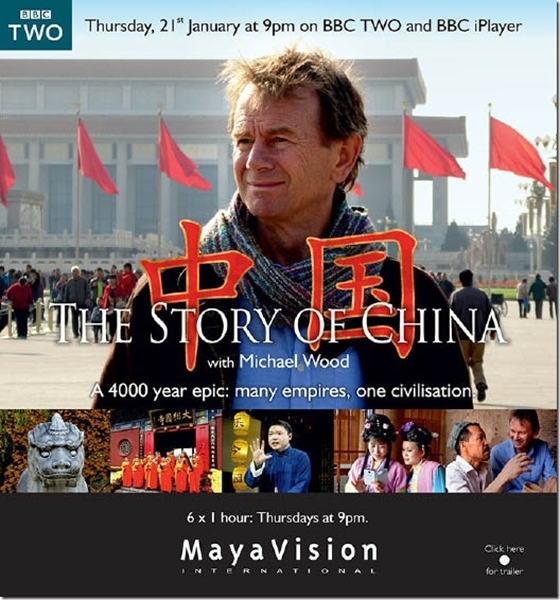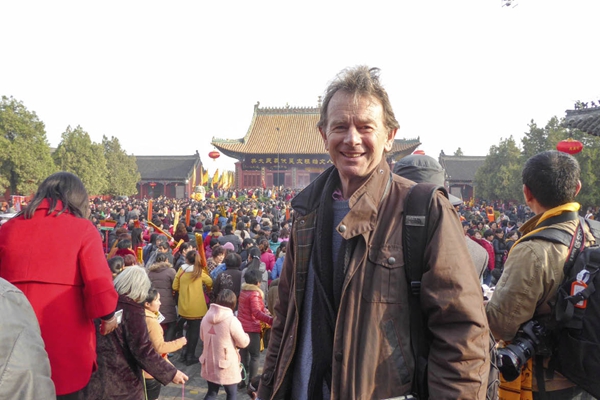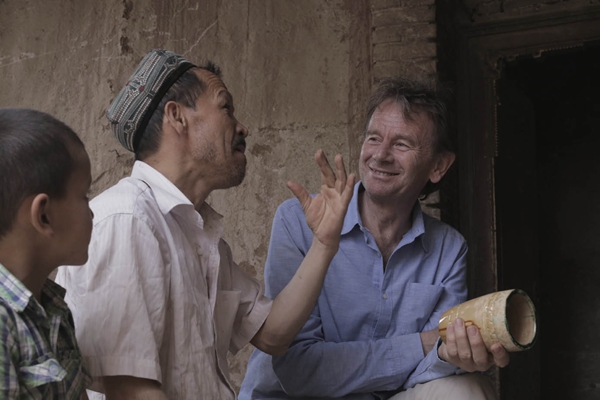By YANG SAI
By YANG SAI
A BBC documentary on the history of China presented by distinguished British historian Michael Wood recently aired on U.K. screens. Jointly invested by the U.S. PBS, the six-episode TV program, entitled The Story of China, looked at Chinese history spanning 4,000 years.

The Story of China documentary poster.
Michael Wood, who also wrote The Story of China, talked to us about his latest production. A specialist in British history, Wood has also become something of a connoisseur of Chinese history thanks to the three years he spent filming this documentary.
Warmth of Chinese Tradition
“An American sinologist wrote that the Chinese today have lost their warmth of kinship. I told my colleagues that I was going to retreive and present it to our viewers,” Wood said.
Wood’s roommate at Oxford was a Sinologist often visited by Chinese scholars. Wood listened intently to their discussions at the dinner table, and paid his first visit to China in the 1980s.
He said candidly that China today is much different from what it was in the 1980s. He used to feel anxious that the country would become lost in the process of modernization and end up forgetting its traditions. But he was glad to see during the filming that it is still possible, to find “Chinese culture” hidden in the old streets and alleys. “If you walk a few more steps or turn a corner, you will find yourself in a distinctly Chinese scenario.”
When asked what his favorite Chinese city and story was, Wood hesitated because he found so many people and stories touching and impressive. One elderly man had hidden the memorial tablets of his ancestors in the roof during the “cultural revolution (1966-1976).” Several decades later, his grandson found them during renovation of the building, and placed the tablets in a family shrine. Wood vividly recalled details of his visit to that family – the narrow street paved with cobbles, fish drying in the courtyard, and the creaking of the wooden stairs.
He was impressed by scenes of schoolchildren reciting a poem by Du Fu (712-770), a birthday banquet for a 90-year-old woman in a village, and a storyteller in Yangzhou narrating tales from Outlaws of the Marsh.

Michael Wood at a discussion of Du Fu’s poems with students at Yanshi Middle School, Henan Province, site of the poet’s tombstone.
The documentary series began with the theme “Ancestors.” In this episode Wood joined the Qin clan in Wuxi City on the day of the Tomb-sweeping Festival, and filmed the family getting together and holding a grand memorial ceremony for their ancestors. The documentary concluded with the story of another Chinese family’s joyful and warm experiences during the Spring Festival, and looked at expectations of China’s future.
Oral History
The documentary presented perspectives and stories rarely seen by or known to the public. A member of the production team, Susanna Thornton, who obtained a DPhil in Chinese at Oxford, attended an event at the School of Oriental and African Studies (SOAS), University of London. There, during a symposium on the Taiping Rebellion (1851-1864), she discovered that many of the attending experts had never been to Guiping of Guangxi, where the peasant rebellion erupted. Nor did they know whether there were surviving descendants of witnesses to the rebellion. Thornton, therefore, galvanized her Chinese colleagues to look at the documentary evidence and visit the epicenter of the rebellion, Gulinshe Village.
“We were thrilled to find a villager who could precisely recall the events of the time. He was a descendant of the entourage of Feng Yunshan, one of the leaders of the rebellion,” said Thornton. At one point, he asked Thornton if her team had heard about him from Japanese researchers, because for many years, only Japanese scholars had shown interest in the rebels’ descendants.
Concise Stories from a Western Perspective
Broadcast by the PBS and the BBC, the documentary’s audience was expected to have little knowledge about China. “They would never have heard of Emperor Kangxi (1654-1722), for example,” Thornton said, “so we put effort into building a bridge between the history of China and the modern-day public in the West.”

Michael Wood at a temple fair in Zhoukou, Henan Province. Photos courtesy of Maya Vision.
To help viewers’ understanding, Western notions such as “Renaissance” were used for Chinese events. For instance, so as not to overload the Western audience with names of Chinese people and places, the film crew dubbed the great poet Du Fu the “Chinese Shakespeare” and Zhang Dai (1597-1679), a scholar who lived through the collapse of the Ming Dynasty (1368-1644), the “Chinese Proust.”
The production team carefully selected the time periods that would most interest a Western audience, such as the Tang Dynasty (618-907), the first dynasty known for its internationalization wherein Christianity was introduced into China; the Taiping Rebellion, inspired by the Western church; and the Boxer Uprising in the late 19th century that set out to “support the Qing Dynasty (1644-1911) and wipe out foreign invaders.”
When talking about Chinese history, the Opium War between China and Britain is unavoidable. As a product of the U.K., the documentary was very cautious with regard to this period of history. The film crew interviewed two Chinese scholars who gave their own points of view.
According to Michael Wood, Great Britain is, of course, ashamed of that part of history – an unjust war incurring the humiliation of China. But China has since changed. Some British viewers lamented what the U.K. had done at that time, others were impressed by the historical evolution that so deeply influenced the history of modern China. In retrospect, Wood said, we could see the war triggered a series of complicated, unpredictable events, leading China down a different path.
“Since that time, the histories of China and Britain have intertwined.”
China through Different Eyes
In our interview, Wood repeatedly mentioned that six episodes were too short to accommodate the many stories of China. Telling a 4,000-year-long history in six hours is difficult, let alone covering every historical event, cultural aspects, art, science, and customs. “That was the hardest part of making the documentary,” Wood said. The six episodes include: Ancestors; Silk Roads and China Ships; The Golden Age; The Ming; The Last Empire; and The Age of Revolution.
“Ordinary Chinese people were the focus of our filming.” Wood believes that his narration is different from documentaries made by China Central Television and avoids a cold scholastic style. He said he preferred to find clues about history from ordinary people and their life, and to trace their ancestors’ lives and stories.

Michael Wood chats with potters in Kashgar, Xinjiang.
During the shooting, he and his team went to China 12 times. From Kashgar of Xinjiang to Harbin of Heilongjiang, from Beijing to Guiping, he visited places across the country. The 67-year-old was jet lagged, and “had not taken any leave for two years,” he said.
Despite fatigue, Michael Wood was most expansive about what he had seen and heard in China: “The filming went very well. There was no strict control as per the Western stereotype of China.” The Chinese were happy to be photographed and always welcomed the crew, he added. “If I get another opportunity like this, I will make more films about China. I now have many more ideas about this country.”